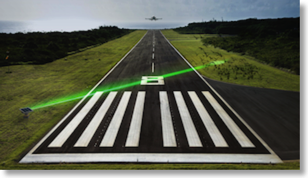Home
A comprehensive resource for safe and responsible laser use
UK: Man uses laser pointer to "improve" Mars' atmosphere so he can claim it as his own
Dr. Philip Davies does not think he will substantially cause a greenhouse effect on Mars. His effort is primarily to point out shortcomings in the wording of the treaty, that in turn could lead to revisions. Davies' goal is to prevent militarization of Mars or other off-Earth bodies.
To help publicize his effort, he is claiming he owns Mars and is selling plots of Martian land, with a few acres going for one U.S. cent.
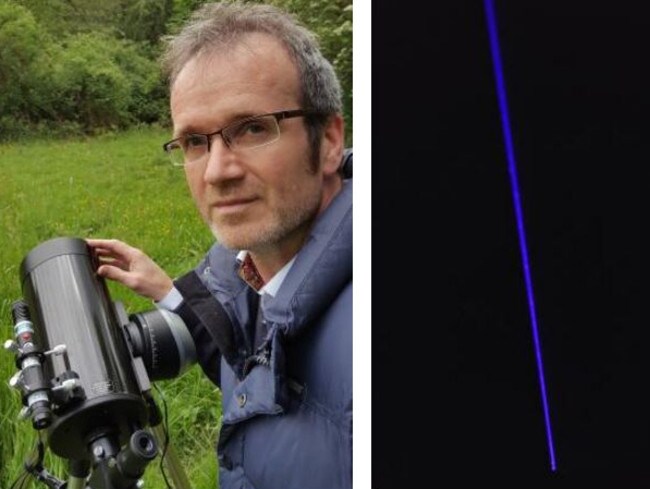
The laser pointer can be seen on the left side of Dr. Davies' telescope. At right is the beam it projects into the sky. From the look of the laser, it's output power is probably in the low Class 4 range, around 500 to 1000 milliwatts (1/2 to 1 watt).
From News.com.au. Davies' efforts have been the subject of numerous news stories such as from the Daily Mail. Do an internet search for "Philip Davies laser Mars" to find the latest on his efforts.
UK: Reports of UFO over Coventry turns out to be light show laser
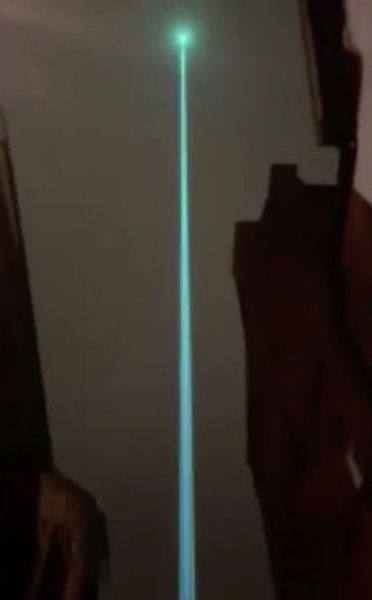
The blue-green shaft of light was from a laser said to be "the world's most powerful display laser." According to Mat Lawrence from the laser company Kvant, advance notice had been made to the U.K. Civil Aviation Authority before the test was done.
Lawrence said the beam could be seen from 20 miles away.
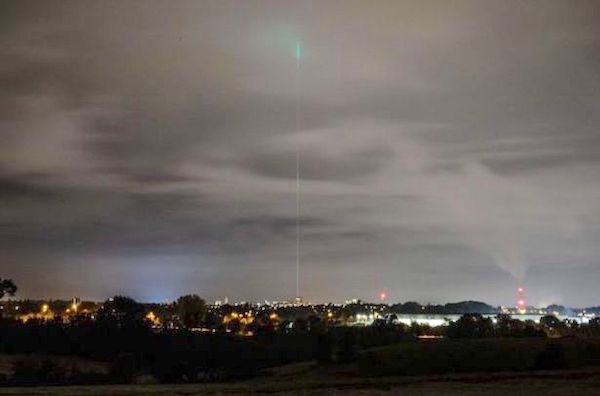
From The Star and Coventry Live
UK: Petition to ban all laser pens looking for 10,000+ signatures
Claire Tucker undertook the effort out of fear for her husband Dan's safety. As of early September 2020, a Wiltshire air ambulance had been illuminated four times by laser light. Her husband was involved in at least one of those, on September 7, in which he saw 'red spots for a while after the laser caught him."
That night, Claire Tucker made an emotional appeal on Facebook, which was also put online by BBC News. In it she said, in part:
"Last night, Dan was in the helicopter, and all of a sudden, they were just about to come in to land. So all of a sudden, the laser light came in and caught Dan's goggles. So when it hits the goggles, it magnifies it. Number one: It could blind him. It could mean that he never gets to see his children again. If they were unlucky enough to hit the pilot's goggles, it could: A, blind the pilot, but B, disorientate the pilot, which will mean the helicopter hits the ground. Okay? So you're going to cause a helicopter crash… If you know anybody that has one of these lasers, please, take it off them, throw them out. Somebody knows somebody who's got these bloody lasers. Alright? It needs to stop. I do not want a knock on the door in the middle of the night by the police because the helicopter has come down."

Tucker during her Facebook appeal
She researched pointers online and found a laser pen on eBay with a claimed 50 mile range for £12 (USD $15.50). Her goal is to get laser pens banned for sale and importation.
Canada: Laser used to help Parkinson's patients walk more steadily now available
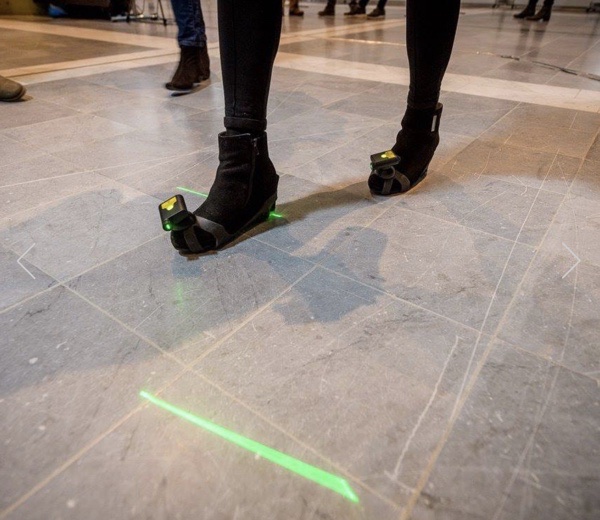
According to the manufacturer, "Path Finder is a shoe attachment that provides visual laser cues for patients suffering from Freezing of Gait (FoG), a symptom of Parkinson’s (PD) and other neurological disorders, severely impacting gait and quality of life. These visual laser cues are in the form of horizontal lines, prompting the individual to take steady steps with both feet, one after another. This hands-free device is meant for individuals with unsteady gait, and can be used to gain confidence, regain mobility, prevent falling and improve quality of life."
It uses a green Class 2 laser, meaning the light is considered safe for normal operation. According to LaserSafetyFacts.com's page on Class 2 lasers, "It normally would not harm an eye unless a person deliberately stared into the beam."
The idea for Path Finder came to inventor Lise Pape in 2014, after watching her father struggle with Parkinson's. She became aware that visual cues such as lighted canes had been used with some success to help trigger a normal step response. She started work on a prototype in 2014, and the product came to market in 2017.
It has won more than fifteen awards, including the AXA Health Tech and You Award in the UK in 2016 and Vodafone TechStarter in the UK in 2019.
Story from Digital Health with information from the Path Finder website and news blog.
UK: Animal lovers protest using lasers to scare away geese
The manager of Hall Place, the Bexley council, introduced the laser to reduce the number of geese.
According to a May 17 2019 news story, "The geese are said not to be hurt by the laser and perceive the approaching beam as a physical danger or predator-like presence and so disperse."
But members of the public and the Royal Society for the Prevention of Cruelty to Animals raised concerns. Some of these were about the safety of aiming laser light towards the animals. An RSPCA spokeswoman said: “As with humans, we would not support shining a laser directly into an animal’s eye."
Other concerns were about forcing the geese to leave their "home." One person who started a petition said "The laser shoots out this green light that gives a shock that tells them it is not safe… If we keep pushing them away, there will be nowhere for them to go."
From the Evening Standard
UK: 200+ laser pen injuries illustrate the risk to children, especially with behavioral problems
The study looked at 77 case reports of laser eye injuries in children. In four of the cases there were reported psychological or behavioral issues.
In addition, the authors had experience with four children with laser eye injuries; in three of these cases there were psychological or behavioral issues.
One of the authors sent a survey to 990 consulting ophthalmologists in the U.K. This found 159 cases of macular injury due to "misuse of a handheld laser device," with 80% of those injured being children or teenagers. In 35% of the cases, the injury was self-inflicted; in 36% it was caused by a third-party. (The remaining 29% seem to be uncategorized although the paper notes that "there were no cases of assault reported." In 67% of the cases where the laser power was known, it was under 50 milliwatts.
The paper cautions that the actual number of laser injuries seen by the ophthalmologists may be higher: "A limitation was the poor response rate and thus data so obtained do not provide the true incidence and clinical features of such cases."
Click to read more...
UK: BAE Systems can filter 3 laser wavelengths with 70% normal transmission
According to an October 31 2018 story about BAE's anti-laser efforts, "Bray says a lot of work has gone in to developing products that protect pilots from this form of attack; now much of the challenge is about developing the frames to house the filters."
The story also discussed the number of reported laser incidents in the U.S. and U.K. in recent years, concerns about laser use against military aircraft in the East China Sea and East Africa, and Chinese development of dazzling and blinding laser weapons.
It concludes with Bray's discussion of challenges for laser eye protection: "Among them are achieving performance for off axis incidence of laser, a high absorption at the wavelength of interest whilst keeping the transmission high elsewhere, and ensuing they work, something not easily done given the risk to individuals if they don’t work.”
From Air Force Technology
UK: Home Secretary wants more power for police to search for laser pointers
Javid will open a public consultation to extend the power of "reasonable grounds" (to search suspects). Proposed changes will go before Parliament.
From September 4 2018 articles in The Times and The Sun
UK: Average of 50 laser illuminations of military aircraft per year in UK
It is not clear if these military incidents are included in the Civil Aviation Authority (CAA) statistics about laser illuminations of aircraft.
The Ministry of Defence figures, made public June 11 2018, were rounded to the nearest 10. The list below shows the reported military-related laser incidents in the UK, along with the CAA numbers for the UK and for overseas UK operators
2013 - 40 military, 1396 CAA UK home, 329 CAA UK overseas operators
2014 - 70 military, 1447 CAA UK home, 317 CAA UK overseas operators
2015 - 70 military, 1440 CAA UK home, 355 CAA UK overseas operators
2016 - 30 military, 1258 CAA UK home, 274 CAA UK overseas operators
2017 - 40 military, 989 CAA UK home, 243 CAA UK overseas operators
The information was released in response to a written parliamentary question submitted by former defence minister Kevan Jones, who said “New laws to deter those stupid enough to carry out these attacks might not be enough, and the Government should give police operating around air bases the resources needed to catch offenders.”
From the Mirror. We have additional statistics and stories about the UK, plus a page with statistics about the UK and other countries.
UK: Professor develops laser-absorbing strip for police face shields; "several thousand" used in Northern Ireland
The strip was developed by John Tyrer of Loughborough University, professor of optical instrumentation. He was commissioned by the Home Office and the PSNI who were concerned about increasing numbers of demonstrators aiming laser pens at police.
The light distracts officers and breaks their positions, according to Tyrer. The orange-tinted film is low-cost and simple to apply.
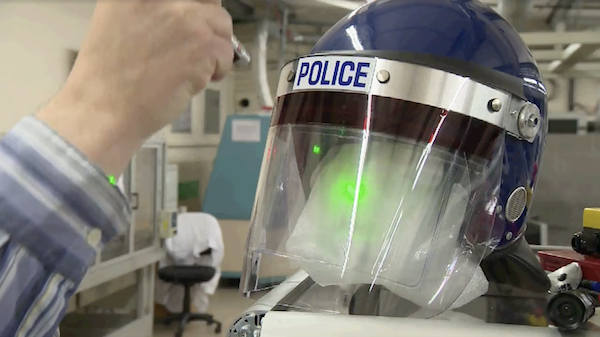
Tyrer demonstrates how light from a laser pen goes through the clear part of the face visor, causing glare and potential eye injury to an officer.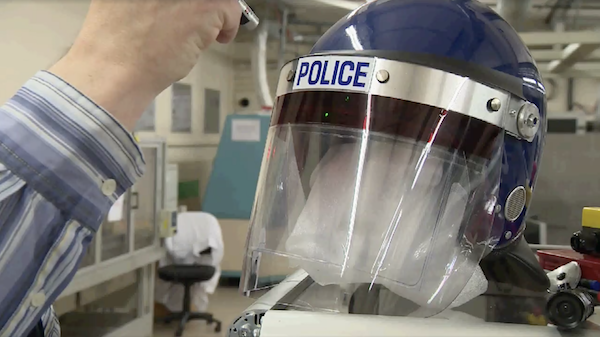
But if the officer tilts his or her head down so the laser goes through the strip, laser light is absorbed and does not present a hazard.
Testing by Public Health England, and real-life usage in Northern Ireland, showed the anti-laser strip to be “very effective”.
Tyrer has also suggested that the same film applied to glasses can protect pilots during takeoffs and landings from any laser activity that might be occurring.
From the Loughborough News Blog and Police Oracle
UPDATE JULY 27 2020: The visor strips are sold by Laser Optical Engineering Ltd. in the U.K. Pricing is £25 (USD $32) per strip in low quantities (<200). According to LOE, in field use it was found that direct attacks on police "stopped quickly" once protesters knew their lasers were ineffective and that laser attackers would be identified and arrested. LOE also sells anti-dazzle glasses. Pricing is £50 (USD $64) each in low quantities (<50).
Additional information about laser use and mis-use at protests, and ways to protect eyes is on the Laser use during protests page.
UK: NPAS says only 1.4% of laser perpetrators were prosecuted
James Cunningham told Police Oracle in a March 21 2018 article that there were a number of reasons for the low prosecution rate, including being not being able to follow the laser perpetrator due to being focused on another job (e.g., completing the original mission).
Also, when lasers are pointed from a tower block area, the helicopter crew may not be able to locate the source.
In 2017 there were 67 incidents [not clear if this is NPAS only], compared with 70 in 2016 and 103 in 2015. Cunningham said the reduction is because NPAS is trying to locate and pursue laser perpetrators, and report the incidents as crime. He said the Laser Misuse (Vehicles) Bill being considered in Parliament is a “step in the right” direction that could lead to more prosecutions.
In December 2017, NPAS purchased laser-reducing glasses which can enable pilots to continue even when illuminated by laser light.
From Police Oracle
UK: New UK law provides stronger penalties, easier prosecution for aiming a laser at a vehicle
The penalties for violations are up to five years imprisonment and an unlimited fine; these penalties take effect starting July 10 2018.
The law applies to laser beams aimed at aircraft, motor vehicles, trains, ships, hovercraft and other vehicles. A vehicle does not have to be moving at the time of offense; if the engine or motor is running then the law applies. Another provision makes it an offense to shine or direct a laser beam towards an air traffic facility, or a person providing air traffic services, under the condition where the beam dazzles or distracts, or is likely to dazzle or distract a person providing air traffic services.
The offense is a strict liability offense, meaning that prosecutors do not need to prove that the person shining the laser intended to endanger the vehicle or air traffic facility/controller. There are two defenses allowed: 1) the person had a reasonable excuse for shining the laser beam, or 2) the person did not intend to shine a laser at the vehicle/ATF/controller and exercised all due diligence to avoid doing so.
Click to read more...
UK: Terror suspect said to tell ISIS sympathizers how to use lasers to bring down an aircraft
Rashid was also alleged to have encouraged ISIS supporters to commit terrorism against 4-year-old Prince George (son of Prince William, Duke of Cambridge, and Catherine, Duchess of Cambridge), against a New York City halloween parade, and against the Burmese ambassador to the U.K.
Husnain Rashid, 32, of Nelson, Lancashire, pleaded not guilty to the charges on April 30 2018. Trial was set for May 14 2018.
From the Express
UK: "Call for evidence" response summarizes many groups' views on laser eye, plane incidents; sets forth actions
The U.K. government published on January 8 2018 a 14-page report on laser pointer safety and potential regulation. The report includes two new actions the government will take to reduce the number and risk of unsafe laser pointers:
1) “strengthening safeguards to stop high-powered lasers entering the country”, and
2) “working with manufacturers and retailers to [voluntarily] improve labeling.
Separately, the U.K. government published the Laser Misuse (Vehicles) Bill on December 20 2017. This makes it illegal to point a laser at vehicles, with a prison term of up to five years and an unlimited fine.
“Laser pointers: call for evidence - government response”
From August 12 to October 6 2017, the Department for Business, Energy and Industrial Strategy opened a “Call for Evidence” consultation. BEIS set forth 19 questions, asking the public to give their views on laser pointer hazards and what actions to take.
The January 8 2018 government response summarizes the 265 responses received.
The report is especially useful because it incorporates the views of many disparate groups: pilots (64% of respondents), “concerned members of the public” (14%), professional laser safety advisors (9%), users of laser pointers (6%), ophthalmologists (6%), and Trading Standards authorities (2%).
The report then distills these views, finding surprising commonality. It is a good overview for the non-expert on two topics:
1) Actual laser pointer hazards — separating fact from fear
2) Potential actions to reduce the number and severity of laser pointer injuries and incidents — including what actions may not work (e.g., licensing).
We have summarized the findings below (click the “read more” link). However, reading the complete document is well worth the time of anyone interested in this issue.
Click to read more...
UK: Laser pen imports to be more restrictive
In addition, “new measures are also being introduced to tackle the sale of unsafe pointers, including more stringent testing.”
The move was supported by the British Air Line Pilots Association (BALPA).
It may help reduce the number of laser pen illuminations of trains (578 incidents were reported between April 2011 and November 2017) and eye injuries (more than 150 reported since 2013, mainly involving children).
Consumer Minister Margot James said the ministry is “going further than ever before” to police the sale of unsafe lasers.
The Argus quoted Professor John O’Hagan, of Public Health England’s laser and optical radiation dosimetry group.He said: “Over time we have become increasingly concerned about the dangers of growing numbers of unlabelled and incorrectly labelled high power laser pointers being bought by the public. It is tragic that we continue to see eye injuries, especially in children. Laser safety experts at Public Health England have worked closely with local authorities in stopping large numbers of these lasers reaching UK consumers. The extra protections proposed should help even further - if you have a laser and you don’t need it, remove the batteries and get rid of it.”
From The Telegraph and The Argus. The stories seem to be a result of the U.K. government publishing, on January 8 2018, a response to their fall 2017 Call for Evidence. The government response included the increased import enforcement actions.
See also the December 2017 news of a new U.K. law that provides stronger penalties for aiming at aircraft. The new import/consumer initiative seems to be part of the government thrust against illegal and overpowered laser pens.
UK: New UK law to provide stronger penalties, easier prosecution for aiming a laser at a vehicle
The text of the bill is here. A House of Lords Summary Briefing, giving some background, is here.
Tough new penalties for misuse of lasers
People who target transport operators with laser devices could be jailed for up to 5 years under new laws designed to protect the public.
The Laser Misuse (Vehicles) Bill, which was published today (20 December 2017), will also expand the list of vehicles, beyond just planes, which it is an offence to target with lasers.
Drivers of trains and buses, captains of boats and even pilots of hovercraft will be among those protected by the new legislation.
The bill will make it easier to prosecute offenders by removing the need to prove an intention to endanger a vehicle.
And it will remove the cap on the amount offenders can be fined – which is currently limited to £2,500 – paving the way for substantial sanctions. Fines could be issued in isolation or alongside a prison sentence.
The police will also be given additional powers to catch those responsible for the misuse of lasers.
Aviation Minister, Baroness Sugg said:
“Lasers can dazzle, distract or blind those in control of a vehicle, with serious and potentially even fatal consequences.”
“The government is determined to protect pilots, captains, drivers and their passengers and take action against those who threaten their safety.”
Alongside their existing powers of arrest and the ability to search a person once arrested, officers will no longer need to establish proof of intention endanger to a vehicle, aircraft or vessel, making it easier to prosecute swiftly. It will be an offence to shine or direct a laser towards a vehicle if it dazzles or distracts the operator, if done deliberately or if reasonable precautions to avoid doing so are not taken.Click to read more...
UK: Firm developing active optics to block laser light, for use in glasses and visors
It can be integrated into visors, goggles or other eyewear. Below is an “early prototype” showing detectors above the nose bridge and batteries on one earpiece:
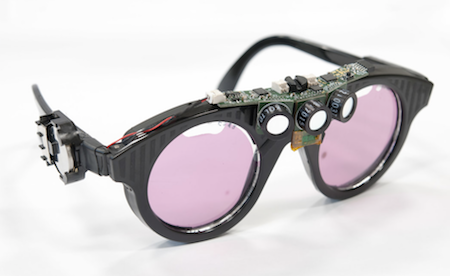
They began work on the “laser dazzle visor” in 2014 and hope to start selling to military, airline suppliers and emergency services in 2018.
From Folium Optics and the Express
UK: 19 questions UK government is asking advice on by October 6 2017
Interested parties are requested to submit answers to these questions — and any free-form answers as well — via an online survey, by postal mail, or by sending an email by October 6 2017.
Additional information and links about the U.K. call for evidence are here.
1. What do you consider to be the scale of the problem with laser pointers? Is the problem specific to high-powered laser pointers (those with a strength of 5 mW or above), or a particular class of laser pointers? What evidence do you have to support your view?
2. How well do you think the current legislation is working? Is the current guidance on safe use of laser products sufficient?
3. Is the current guidance on manufacturing and importing laser pointers sufficient?
4. Do you have any further evidence about the nature and misuse of laser pointers?
5. What legitimate uses are there for high-powered laser pointers?
6. Have you ever purchased, sold or made a laser pointer? If so, can you provide more information about where you bought or sold the product (or its component parts), and what the intended use was?
7. (Enforcement Bodies) Do you know/can you estimate the number of manufacturers, retailers, importers and/or distributers within your Local Authority area?
8. What strength laser pointers do you make/sell? What is the price of each strength laser pointer that you make/sell? Is this a seasonal product (e.g. do you sell more at Christmas)? How many do you sell annually?
9. What is your target market?
10. (If you are an enforcement authority) Have you undertaken any enforcement actions with respect to laser pointers, and if so what were they?
11. (If you are an enforcement authority) What do you estimate as being the level of compliance with the General Product Safety Regulations for laser pointers in your area? On what evidence do you base this?
12. Do you think a licensing system to control the sale and purchase of laser pointers would be effective?
13. What do you estimate the costs of implementing a licensing system to be? How should these be recovered?
14. How might a licensing regime operate? Who should administer a licensing system? Who should enforce it?
15. Are you aware of any other licensing systems in the UK or in other countries – either for laser pointers or for similar products - which might provide the Government with a useful comparison?
16. Do you think that a ban on advertising laser pointers would be effective? Why?
17. How else might Government and other public authorities increase public awareness about the potential dangers of laser pointers?
18. How else do you think that the supply of high-powered laser pointers could be restricted? Why?
19. Do you have any other comments or views which might inform the Government’s recommendations?
UK: Government asks for ways to crack down on laser misuse; deadline is October 6
The government is concerned both with hazards from aiming laser pointers at pilots, drivers and train operators, and the potential for retinal damage among consumers when high-powered lasers are aimed into eyes.
They opened a consultation asking for suggestions for eight weeks, starting August 12 and closing at 11:45 pm on October 6 2017. A 23-page Call For Evidence PDF document is posted at the open consultation webpage. It includes background information on laser hazards and misuse.
There are 19 specific questions asked by the government, plus it is possible to respond with free-form text. Persons can respond via an online survey, by postal mail, or by sending an email.
The full text of the government’s press release is below.
From the UK government press release “Government crackdown on misuse of laser pointers”, the open consultation “Laser pointers: Call for evidence” webpage, and the call for evidence online survey webpage.
Click to read more...
UK: Pilots upset after proposed anti-laser law dropped
Despite “dangerously high” figures on laser attacks on aircraft, the new Government has dropped plans to introduce tougher laws, a move which the UK pilots’ association says is “infuriating and dangerous”.
BALPA had been campaigning for the tougher laws in response to consistently high reports of laser attacks on planes year on year. Last year’s figures stood at more than 1,200 reported attacks.
Before the [June 8] general election, the British Airline Pilots’ Association (BALPA) was pleased to see a specific laser offence included in the Vehicle Technology and Aviation Bill. The new offence proposed that offenders could face up to five years in prison if they shone a laser at an aircraft.
However, BALPA has now learned that the Bill will not now include the laser regulations.
The association has constantly warned that shining a laser at aircraft is extremely dangerous, particularly in critical phases of flight such as take-off and landing, putting the lives of passengers at risk. BALPA General Secretary, Brian Strutton, said:
“It is infuriating to see the changes we’d hoped for appear to have been discarded. Not having this legislation is dangerous and puts the lives of passengers and crew at risk.
“The proposed tougher laws received cross-party support so it’s baffling that they have been dropped.
“When a laser pen is pointed at an aircraft it can dazzle and distract the pilot, and has the potential to cause a crash. Last year’s incident figures remain dangerously high, with the equivalent of more than three laser attacks a day across the UK.”
The Guardian has a June 22 2017 story about BALPA’s criticism, with additional information and statistics on U.K. laser incidents.
An April 20 2017 analysis of the Vehicle Technology and Aviation Bill, written by the law firm of Addleshaw Goddard LLP, had this description:
The Bill makes it an offence to direct or shine a laser beam at a vehicle in such a way as to dazzle or distract the person driving, piloting or navigating that vehicle.
This offence is not completely new. Under section 225 of the Air Navigation Order 2016, it was an offence to 'dazzle or distract' the pilot of an aircraft and under section 240 it was an offence to 'recklessly or negligently act in a manner likely to endanger an aircraft, or any person in an aircraft'. Many have argued these offences are insufficient as they are limited to aircraft, and are summary offences only which restrict police powers. The new offence therefore applies to all 'Vehicles', which are defined as anything used for travel by land, water or air and so will apply in relation to trains, buses and other forms of transport. The penalties remain the same: a maximum fine and imprisonment for up to 5 years.
However, many still consider the new offence insufficient. A number of organisations and rights groups wanted lasers to be reclassified as offensive weapons when used in some circumstances, particularly following the failure last year of a Private Members Bill which had sought to make the sale of high wattage lasers unlawful in certain circumstances.
UK: 1,258 laser/aircraft incidents in 2016, a 12.6% drop from 2015
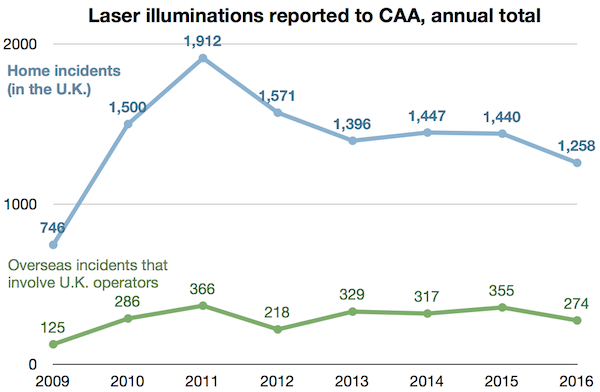
Note: Previous stories and charts elsewhere on LaserPointerSafety.com may have slightly different figures for some years. This is due to CAA updating numbers after a “SDD Coding Backlog”. The numbers above are all as reported in February 2017 by CAA.
The 1,258 home incidents in 2016 represent a 12.6% decrease from the 1,440 home incidents that occurred in 2015.
Similarly, the 274 overseas incidents in 2016 represent a 22.8% decrease from the 355 overseas incidents that occurred in 2015.
Here are the 1,258 home incidents in 2016, month-by-month:
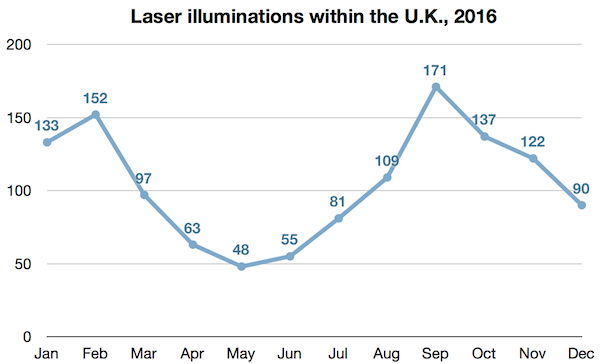
CAA listed the top 10 locations reporting laser incidents for 2016. It is not known whether these incidents all occurred at or near the indicated airports, or whether this also includes incidents (such as helicopter strikes) that occurred elsewhere but which were tallied to the closest airport.
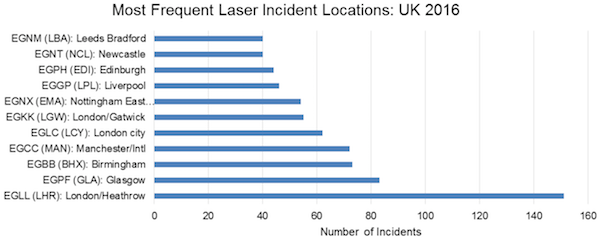
As in the United States, the majority of laser illuminations were reported to be green. The figures below are for U.K. incidents; the color distribution is roughly the same for overseas incidents as well.
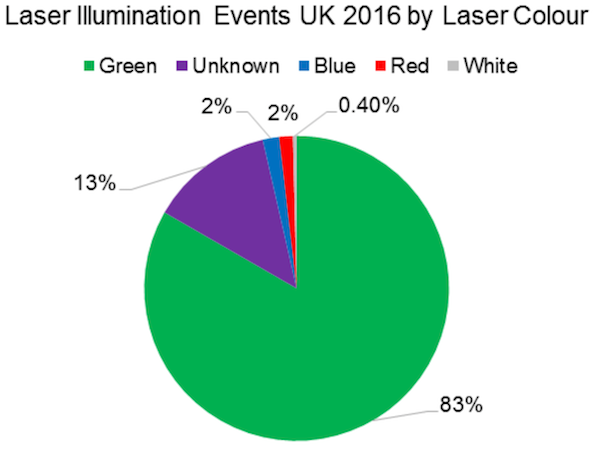
From a February 2017 report by the Civil Aviation Authority. This report contains additional details such as a monthly breakdown for each year 2009-2016, and for each of the top 10 home and overseas locations in 2016.
UK: New law proposes prison for aiming laser pens at aircraft, trains, cars, other vehicles
It is more stringent than the current law which 1) only applies to aiming at aircraft, 2) requires prosecutors to prove that the perpetrator endangered the aircraft and 3) has a fine of up to £2,500 (USD $3,112).
The new law will 1) apply to a wider variety of transport modes including automobiles, 2) require prosecutors only to prove that the laser was directed towards the transport vehicle and 3) will also add the prospect of prison time to the potential punishment. The exact new fines and prison terms were not stated in the DfT announcement.
Click to read more...
UK: Statistics on police helicopter laser attacks; one has been struck 100 times "over the last year"
Assuming “over the past year” means “in the last 12 months”, that would be an average of about two laser illuminations per week.
A separate article from BBC News states that in 2015 there were 91 reported laser illuminations of National Police Air Service aircraft. The largest number was 20 attacks against NPAS helicopters taking off from its Carr Gate headquarters near Wakefield, West Yorkshire.”
Reasons for the apparent discrepancy in numbers are not clear. It may be that South Yorkshire is not a member of the NPAS, which provides centralized air support to local police forces.
The BBC News chart below shows the 2015 NPAS laser attacks:
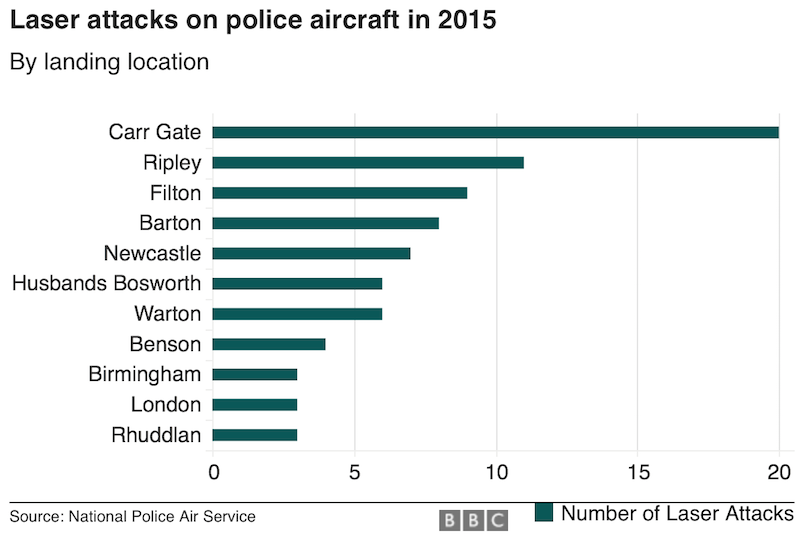
The NPAS is testing laser protective eyewear, as a means to help protect flight crews.
From The Star and BBC News. Interestingly, a September 14 search of the South Yorkshire Police website, to find more information about these incidents and police concern regarding lasers, did not find any results when searching for the term “laser.”
UK: BALPA calls for high-powered lasers to be treated as offensive weapons
BALPA noted that there were 1,439 reports of laser attacks in 2015, and that 55% of pilots experienced a laser attack in the past 12 months. A spokesperson said BALPA “has been campaigning for a long time for high-powered lasers to be treated as what they are — offensive weapons.”
The association was also concerned with the threat of incidents involving drones.
A motion to ask for improved regulations passed at the meeting.
From a BALPA press release
UK: Arrest persons carrying "high-powered" laser pointers in public, says top aviation regulator
According to Haines, laser attacks have permanently damaged pilots’ vision, and it is conceivable that they could cause an aircraft crash. In 2015 there were 1,439 laser incidents reported to CAA.
Haines said there is no legitimate reason for a person to have a high-powered laser pen in public. Press reports did not indicate Haines’ definition of “high-powered”. (In the U.K., lasers used as pointers are limited to 1 milliwatt [the U.S. limit is 5 mW], so it is possible that “high-powered” would mean any handheld laser above 1 mW.)
Haines asked “Why does Joe Bloggs walking down the street need a laser that can pop a balloon at 50 miles, that can cause permanent damage to a pilot?”
The CAA chief wants new, restrictive legislation because at present, it is difficult to find laser perpetrators and to prove they had intent to endanger aviation, under the Air Navigation Order 2009.
A U.K. government spokesperson said "We take this issue very seriously and we continue to work with other Government departments, the CAA and industry to determine how best to control the sale, use and possession of laser pens. We are looking to make changes as soon as possible."
From the Daily Mail, BBC, the Mirror, and other news sources. For commentary about Haines’ statements, click the “Read More…” link below.
Click to read more...
UK: Money from convicted terrorist used to buy laser pointer
There was no indication as to any intended use for the devices.
According to a July 28 2016 report, Adeel Ul-Haq, 21, received a five-year sentence for “helping in the preparation of an act of terrorism” and a one-year sentence for “funding terrorism.”
Ul-Haq raised approximately £4,200 (USD $5560) via Twitter donations. Some of the money purchased the laser and night-vision equipment.
The money was confiscated, and was redistributed by the Charity Commission to two registered aid charities.
From CivilSociety.co.uk
UK: Consumer lasers hazardous up close, but will not injure pilots, say 3 top UK experts
But in addition to this declaration, the authors also provided a succinct summary of the current state of consumer laser pointer misuse, and how ophthalmologists should proceed when studying a patient’s laser exposure.
Experts John Marshall, John O’Hagan and John Tyrer began by noting that low-powered Class 2 (less than 1 milliwatt) and Class 3R (1-5 mW) lasers “are not an eye hazard, and even if used inappropriately will not cause permanent eye damage.”
However, consumer laser devices with Class 3B (5-500 mW) and Class 4 (above 500 mW) powers have begun to cause injuries. “….[C]lass 4 devices are capable of causing irreversible retinal damage if directed into the eye over short ranges, up to several metres. Such devices have resulted in foveal injuries in children with current estimates of 150 cases in the UK. The [UK] media has given significant coverage to this growing problem.”
Ophthalmologists were advised that in cases of close up exposure, there may potentially be permanent damage. A detailed examination would be warranted, although there is no treatment to reverse permanent damage.
The hazards from this short range misuse differ from the hazards of aiming a laser towards pilots. Because the laser-to-aircraft distance is typically “hundreds to thousands of metres”, and because of scattering from the windscreen, eye injuries are nonexistent: “Fortunately, these exposures are at irradiances that are incapable of producing irreversible retinal damage even at distances of 100 m.”
They said that only one case of alleged retinal damage has been reported in pilots. [LPS.com note: this is for publicly available reports involving civilian pilots.] The experts concluded the case is suspect for a number of reasons; they do not believe laser targeting caused the alleged injury.
Marshall, O’Hagan and Tyrer turned from injuries to the hazards of distracting pilots with bright laser lights: “Obviously, if such a distraction occurs at a critical time such as during landing then the result could be devastating.”
For ophthalmologists examining pilots, if there are no permanent abnormalities on an Amsler grid test, the physician should not do any detailed eye exam, as this “would only serve to compromise the pilot's vision for a longer period.” The authors noted that pilots may delay seeing an expert for “many hours or a day or so during which there may be a growing psychological element.”
In an interview with CNN, Marshall said the findings on pilot hazards are based on previous laser safety research as well as a new study done with field experiments at a military base over about three years.
In the BJO editorial, the three experts agreed that current laser safety standards and guidelines are based on valid experiments and science. The standards do not need to be revised, “…but clearly further attempts must be made to educate the public.”
The editorial concluded “The European Commission has mandated the European Standardisation bodies to produce a standard specifically for consumer laser products. This should allow enforcing authorities to remove unsafe products from the market. However, compliance by manufacturers will remain an issue, as will direct imports by the public purchasing unsafe laser products over the internet.”
From the British Journal of Ophthalmology editorial “Eye hazards of laser ‘pointers’ in perspective” by John Marshall, John O’Hagan, and John Tyrer, available in HTML text and as a PDF document. Click on the blue “Read More…” link below for an April 19 2016 press release from the BJO summarizing the paper’s findings relative to pilot hazards.
Click to read more...
UK: Government safety expert says eBay needs to crack down on sale of lasers
Dr. John O’Hagan said that many of the handheld laser pens and pointers being sold on eBay “are very clearly not one milliwatt.” According to eBay guidelines, such lasers above 1 mW are not supposed to be listed. O’Hagan noted that the pens may be “misleadingly …. designed to look like less powerful lasers, and are priced at only around £5 [USD $7], so people may not even be aware of what they are buying.”
From the Sun; scroll down to the “Lasers” section. See also a similar warning from a UK laser pointer seller.
UK: Laser pointer seller says eBay is the main source of UK illegal high-powered lasers
Loudon estimates that eBay sales “are in the thousands” each day. According to the statement, “Currently there are over 2000 laser pens for sale on eBay UK. It appears 90% of the listings are for products that are clearly over 1mW and often with sales histories of thousands in a single listing. Multiply that and it becomes really obvious where all these overpowered lasers are coming from that idiots are abusing.”
He calls for eBay to begin “monitoring and delisting all these crazy hyped up laser listings”.
From a statement emailed to LaserPointerSafety.com on February 17 2016. The complete statement is reprinted below; click the “Read More…” link. And click here for other eBay-related stories, including one a day later where a UK public safety official called on eBay to “crack down” on laser sales.
Click to read more...
UK: Government department in talks to possibly withdraw high-powered lasers
The meeting is scheduled to occur during the week of February 22-26. A department spokesperson said on February 16 that it was too early to discuss any potential changes to laws.
From the Telegraph
UK: BALPA calls for "more action" after Virgin Atlantic flight diverts back to takeoff airport
The following is from the BALPA website, Feb. 15 2016. More news items referencing BALPA are here.
LASER INCIDENT SHOWS MORE ACTION IS NEEDED
15/02/2016
Last night’s laser attack incident clearly shows why more needs to be done to tackle the growing use of lasers against aircraft.
The crew of Virgin Atlantic flight VS25 bound for New York took the decision to return to Heathrow after reportedly being attacked with a laser shortly after take off.
Jim McAuslan, General Secretary of BALPA, said,
“This is not an isolated incident. Aircraft are attacked with lasers at an alarming rate and with lasers with ever-increasing strength.
“It is an incredibly dangerous thing to do. Shining a laser at an aircraft puts that aircraft, its crew and all the passengers on board at completely unnecessary risk.
“Modern lasers have the power to blind, and certainly to act as a huge distraction and to dazzle the pilots during critical phases of flight.
“We are sure the police will do everything in their power to find the culprits of this attack and prosecute them.
“We repeat our call to the Government to classify lasers as offensive weapons which would give the police more power to arrest people for possessing them if they had no good reason to have them. This incident shows why this is becoming more-and-more urgent.
“Pilots across the world know how dangerous laser attacks are and therefore will join with me in commending the actions of the crew of VS25 who put their passengers’ safety first and took the decision to return to Heathrow.”
UK: Around 9,000 laser incidents, Jan 2009 - June 2015, according to CAA
For comparison, in the United States from January 1 2009 through May 31 2015, there were 21,414 laser incidents reported to the Federal Aviation Administration. (An additional 457 incidents were reported during June 2015.) From January 1 2004 through December 31 2015 there were 29,097 laser incidents reported to FAA.
U.K. information from the Daily Mail. U.S. information from FAA data.
UK: UPDATED - Medical report on commercial pilot injured by blue laser at 1300 feet
“An airline pilot presented to our department complaining of a blind spot in the upper left area of his visual field in the right eye (right supero-nasal scotoma) following exposure to a laser beam while performing a landing maneuver of a commercial aircraft. At around 1300 ft (396 m), a blue laser beam from the ground directly entered his right eye, with immediate flash blindness and pain. Spectral domain ocular coherence tomography highlighted a localized area of photoreceptor disruption corresponding to a well demarcated area of hypofluorescence on fundus autofluorescence, representing a focal outer retinal laser injury. Fundus examination a fortnight later revealed a clinically identifiable lesion in the pilot’s right eye commensurate with a retinal-laser burn.”
The paper said the pilot’s symptoms “fully resolved 2 wk later” and that there was no “deficit in visual function.”
Click to read more...
UK: Police get advice from U.S. FBI on stopping U.K. laser incidents
While both the U.S. and the U.K. have laws with penalties up to five years in jail, in the States jail sentences have been imposed while fines are the norm in Britain. The U.S. also has a centralized national reporting system, which the British officials seek to emulate.
Mark Callaghan, an NPT inspector for Sussex Police, told the Express about a case in April 2014 where a laser beam was aimed at an Airbus A319 from a Travelodge near Gatwick Airport. The pilots reported that “The green laser was extremely aggressive and we suffered three or four two-second attacks directly into the cockpit causing blotchy vision, squinting, broken concentration, sore eyes.” The perpetrators were not caught.
Callaghan noted “We can find out who was in the rooms but we have no power to conduct any searches and even if there were lasers there what evidence is there to say they did it? We would like some preventative legislation. The US have got it nailed on how they deal with this.”
From the Express
UK: 400+ laser incidents in the first half of 2015
From January 1 to June 30 2015, there were more than 400 laser incidents reported to CAA. Heathrow had the most incidents by count, with 48 in the first half of the year. (This is actually fewer incidents per month than last year, when there were 168 total Heathrow laser reports for all of 2014.)
By proportion of laser incidents to air traffic volume, there was a higher frequency of attacks at regional airports such as Birmingham, East Midlands, Leeds Bradford and Newcastle.
The British Airline Pilots’ Association (BALPA) on November 2015 released the results of a survey of its pilot members, showing that 50% had reported a laser/aircraft incident during the period from November 2014 to November 2015.
From the Guardian and the Express. The CAA and BALPA statistics were released along with news of a British Airways pilot who reportedly suffered severe retinal injury from a spring 2015 exposure to a “military-strength” laser.
UK: 1,442 laser incidents in 2014; up 3.4% over 2013
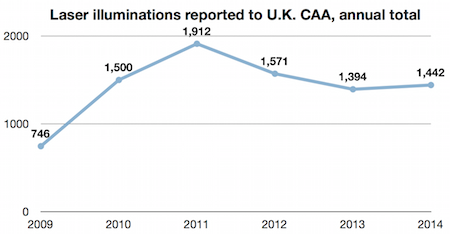
Additionally, there were 312 laser incidents that occurred outside the U.K. to U.K. operators.
In 2014, the top four most frequent incident locations were London/Heathrow (168), Manchester International (107), Birmingham (92), and Leeds Bradford (81). London/Gatwick and Glasgow were tied for fifth place, each with 64 reported incidents.
CAA published a PDF report with more detailed figures, including a monthly breakdown of the most frequent laser incident locations in 2014, and monthly & yearly totals for 2009 through 2014, and overseas (non-U.K.) incidents occurring to U.K. operators.
From the CAA PDF report dated February 2 2015. Note: There is a discrepancy where one table lists a total of 1,440 incidents in 2014 while another lists a total of 1,442. We have used the larger figure in this story.
Additional charts are on the page listing 2014 incident statistics, and the page with 2004-2014 historical data.
UK: 107 laser pens seized from house near Southampton Airport
In the ten weeks prior to September 26 2014, there were seven incidents of lasers being pointed at aircraft; five of these led to arrests.
News reports did not directly link the misuse to the man arrested with the 107 laser pens. It also is not known if the investigation that led to the seizure was started in response to the aircraft incidents, or was separately initiated. All flights landed safely.
One of the seized pens was said to be 650 times more powerful than normal. Given that U.K. regulations prohibit laser pointers above 1 mW, the pen was likely 650 milliwatts. This is Class 4, the most hazardous laser classification, as the beam can cause eye and even skin burns.
From the Daily Echo
Worldwide: Handheld laser being used by airports to disrupt birds
The Aerolaser is made by the Delft, Netherlands company “Bird Control Group”. The handheld device uses a green laser with a range over 2500 meters (1.6 miles). The company claims that birds do not grow used to the laser, and it is safe for the animals. According to an article at the website IHS Airport360, “As a safety feature, the laser is disabled above a certain height - this prevents the beam from being shone directly at aircraft or controllers in the tower.” In addition, the operator can look through a scope so he or she knows where the beam will be directed.
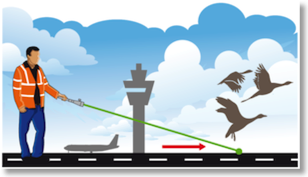
Conceptual diagram of using a handheld laser around airports, from Aerolaser.com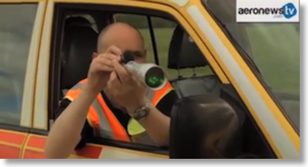
A frame from an Aerolaser video describing use at the Southampton airport.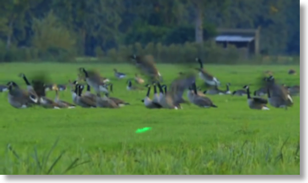
A frame from another Aerolaser video showing laser light scattering birds.
The company also makes an automatic, autonomous system called Aerolaser Groundflex, pictured below from the company’s website:
According to Wikipedia, “bird strikes are a significant threat to flight safety” since 35% of strikes result in damage to the aircraft, costing $400 million per year in the U.S. and up to $1.2 billion per year worldwide.
Bird Control Group also makes the Agrilaser Lite (range of 1000 meters) and the Agrilaser Handheld (range over 2000 meters), intended to keep birds away from fields and crops.
From Aerolaser.com, Agrilaser.com, IHS Airport360, and Wikipedia’s “Bird strike” article
UK: 1300+ laser incidents in 2013
The newspaper also reported that in the 12 months between October 2012 and September 2013, there were 31 reports of aircraft being illuminated as they approached Gatwick Airport, 30 miles south of London.
Laser strikes have also increased on rescue helicopters flying out of Redhill Aerodrome, Surrey, a few miles north of Gatwick. A tactical flight officer was quoted as saying “I've had to break away from a task because of being lasered and it's not because we're trying to catch a bad guy, it's because we're trying to find people potentially in danger.... There are certain elements of society that might be trying to harm us or put us off being in a certain location.”
Police inspector Mark Callaghan told the Mirror that there have been a number of jail terms for perpetrators, but that "Hand-held lasers are easily obtained over the internet or from market stalls and street vendors abroad. The warning labels on these are misleading and they are more powerful than advertised."
From the Surrey Mirror
UK: Toy helicopters use real lasers in a dog fight
A video showing the “AirTerminators Super Combat Helicopters” in January 2014 at the London Toy Fair shows an operator getting a brief laser hit just below his eye. The laser is said to be Class 1; if so, such a brief exposure would not be considered harmful according to safety guidelines.
However, it is not recommended for children to play with lasers. Further, it is unknown if the laser remains operational even if the helicopter is stationary or is handheld instead of free flying.
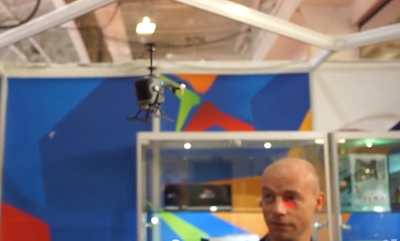
The helicopter is in the middle top of the photo. A red line can be seen just under the operator’s eye. This is the path of the laser from an opposing helicopter as it went across his face during the video frame. This can be seen at 34 seconds into a YouTube video of the demonstration.
From Pocket-Lint. The video is on YouTube.
UK: Pilots want stronger laws, jail, for laser attacks
The Association says the lasers are too easily available, and that although it is illegal to aim a laser at an aircraft, the punishments have been too lenient: “Slaps on wrists and £150 fines are not enough.”
According to a September 29 2013 article in the Sunday Express, there were 1,570 laser incidents reported to the Civil Aviation Authority in 2012, and 1,911 in 2011. The most prominent airports cited were Birmingham, Manchester, Liverpool, the East Midlands, Bristol, Heathrow and Gatwick.
From the Sunday Express
UK: Handheld (industrial) laser easily cuts through metal
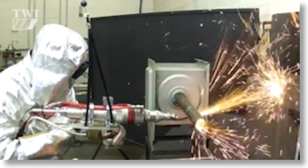
The device came to public attention September 28 2013 when gadget blog Gizmodo published an article entitled Holy Crap, This Real-Life Laser Rifle Cuts Through Metal Like Nothing. The article links to TWI’s YouTube video of the laser in action.
UK: "Blaze" bike light uses laser to caution motorists during night rides
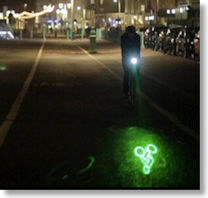
The laser-projected image appears to be formed by a holographic diffraction grating, similar to those used in “caps” on laser pointers to make simple logos such as faces, dollar signs and other graphics:

Blaze’s inventor, Emily Brooke, put the product on Kickstarter in November 2013 and reached its funding goal within 27 days. The initial cost of a Blaze is £60 (USD $96).
A description at Kickstarter states that when Blaze is off of its bracket on the bicycle, the laser cannot be turned on, as a safety measure. The internal laser will be a “more powerful module than you’d typically find in a laser pointer”. However, because the beam is spread out by the optical element, it will be a Class 2 laser product with human access safety equivalent to a laser pointer that is less than 1 milliwatt.
She also notes that the laser is aimed down onto the road so it will not dazzle drivers.
From CNN
UPDATED -- October 27 2014: Blaze is out of Kickstarter and is a product. The new website is at Blaze.cc. According to the website, as of October 2014 the company has sold 3,000 Blaze laser bike lights. The final cost is $200, shipped anywhere worldwide. The laser is a direct-diode green laser, not a DPSS. It is said to be “retina safe.”
UK: More than 220 laser attacks in two years in West Midlands, says CAA
This is roughly one-third of the 700 incidents over the same time frame that involved aircraft in or above the West Midlands. (The 480 non-laser incidents included bird strikes, emergency landings, a bomb threat, a dog on the runways and closure of an airfield because of a flying kite.)
On one occasion in July 2011, four different lasers were aimed at a police helicopter in a single incident.
The British Airline Pilots’ Association asked for prison sentences for persons caught aiming at aircraft, as well as regulations over the sale of high-powered lasers.”
According to West Midlands police, laser attacks on their helicopter have fallen in months prior to July 2013.
From the Birmingham Mail. See also a related LaserPointerSafety.com article on BALPA’s laser pointer suggestions.
UK: Pilots want jail for persons aiming laser pens at aircraft
BALPA general secretary Jim McAuslan asked for a government cross-agency summit to address the problem. BALPA requested stronger regulations restricting the sale of high-powered lasers, more prosecutions, and action taken through trading standards.
He said that hotspots include airports at Manchester, Glasgow, Liverpool and Heathrow.
From ITV London and ITV Granada
UK: Seizure of 7,000+ laser pointers illustrates control problems
7,378 lasers were seized, along with 8,780 parts from which lasers could be assembled. It was estimated that the company sold over 35,000 laser pointers from 2009-2011, generating income of over £1,000,000 (USD $1,600,000).
Techyun Hii, 33, pleaded guilty to four charges of laser pointer violations and a fifth charge of unsafe power chargers. He was sentenced to a 180 day jail term suspended for 18 months, and to 300 hours of community service. The lasers were later incinerated in a hospital’s furnace.
Lead author John O’Hagan detailed the HPA’s findings in a paper presented at the March 2013 International Laser Safety Conference in Orlando. The case had previously been reported by LaserPointerSafety.com.
Click to read more...
UK: Leeds Bradford Airport has 3 laser incidents per week
From the Yorkshire Evening Post
UK: UPDATED - Selling illegal laser pens could net a 3-month sentence for UK man
33-year-old Techyun Hii ran Sky Laser Pointers from his home in Ribbleton, a suburb of Preston, Lancashire. In 2011, Lancashire Trading Standards officials found he had lasers that were up to 150 milliwatts, substantially over the U.K. limit of 1 milliwatts for laser pens sold to the public through an eBay store. Three packages were being sent to Greece, just before the Greek riots. He had been warned twice before about U.K. laws and his obligations.
In April 2012, investigators placed a test purchase which led to Hii’s arrest. He pleaded guilty to five counts of selling illegal goods, and will be sentenced July 4 2012.
From the Lancashire Evening Post
UPDATED November 25 2012: Hii was sentenced to a 180 day jail term, suspended for 18 months and was ordered to carry out 300 hours of unpaid work. The lasers sere destroyed by burning them in a hospital’s furnace. From the Lancashire Evening Post.
UPDATED March 22 2013: The case was the subject of a paper in the Proceedings of the 2013 International Laser Safety Conference, “Laser Product Assessment for Lancashire County Council Trading Standards Service” by John O’Hagan, Michael Higlett and Marina Khazova, pp. 181-188. A summary of the paper is here at LaserPointerSafety.com.
UK: 15 laser incidents at East Midlands Airport in 10 months
Police warned of the hazards of endangering pilots and drivers, and noted that a violation could result in being sentenced to prison for life.
From This Is Derbyshire and the Loughborough Echo
UK: CAA issues Safety Notice to pilots, after 2,300 laser attacks in 2011
Below are highlights from the document, which gives some background information and statistics, and then describes how affected crew should prepare for and react to a laser attack. (Emphasis in bold added by LaserPointerSafety.com.)
Click to read more...
UK: Eye test for pilots available from CAA website
The ALESA card is available in hard copy, and can also be downloaded from CAA’s website. If downloaded, the Amsler Grid on the first page should be printed so it is 10 x 10 cm.
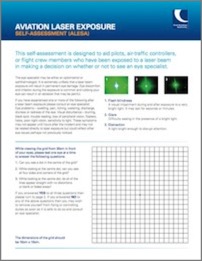
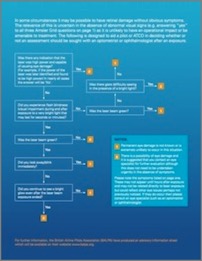
Click for PDF version from CAA ALESA webpage
When staring at the dot in the center of the grid, if the lines appear distorted or there are blank or faded areas, there may be a problem. The person is encouraged to remove themselves from aviation-related duties such as flying or air traffic control, and to see an eye specialist.
The second page has a flowchart of exposure conditions leading either to a “1” meaning unlikely eye damage or a “2” meaning eye damage possibility. If the person scores a “2”, the flowchart suggests they see an eye specialist.
From PilotWeb and the CAA ALESA webpage. The CAA press release about ALESA is here.
US & UK: UPDATED - Laser incident rate in U.K. more than twice the U.S. rate
- U.S. airports had 9,079,000 flights in 2011, with 3,591 laser incidents reported to the Federal Aviation Administration. This is a rate of one U.S. laser incident for every 2,528 flights. Said another way, this is 0.40 incidents per 1,000 flights.
- U.K. airports had 2,152,787 flights in 2011, with 1,909 laser incidents reported to the Civil Aviation Authority. This is a rate of one U.K. laser incident for every 1,128 flights. Said another way, this is 0.89 incidents per 1,000 flights.
The ratio of U.K. to U.S. rates is 2.24, meaning that the U.K. had more than twice the number of laser incidents than the U.S., when adjusted for the number of flights. (Important note: These figures do NOT mean that commercial aircraft are targeted at the rates indicated. Many laser incidents involve police helicopters. The analysis is simply meant to compare the two countries’ rates of laser misuse against aircraft of all types.)
It should also be noted that there could be many underlying factors affecting the precise numbers. For example, it is not known if the U.S. counts laser incidents in the same way as the U.K.
However, the figures do indicate that the U.K. rate of laser incidents appears to be significantly higher -- roughly twice the U.S. rate, based on the number of flights.
From an analysis by LaserPointerSafety.com, March 22 2012.
Updated May 27 2012 to correct a math error and make clear that it is the United Kingdom which has a higher rate of laser incidents (e.g., more incidents per 1000 flights). Our thanks to Brian Turner for pointing out this error.
Methodology: We define a “flight” as a takeoff plus a landing. US flight figures are from the Airline Activity “departures” statistic from the Department of Transportation’s Bureau of Transportation Statistics. It is assumed that each flight which departs also lands, so the data is accurate for “flights” as we have defined it. UK flight figures are from totaling column G, Total ATMs, from “Table 4, 1 Air Transport Movements 2011” found on the CAA UK Airport Statistics 2011 page. A UK “movement” is one takeoff plus one landing, so this is the same as our “flights” definition.
While the flight statistics compare only airline (US) and air transport (UK) flights, and do not include law enforcement flights, we believe this is a valid “apples to apples” comparison of how many more flights take place in the U.S. than in the U.K. A previous LaserPointerSafety.com analysis showed that law enforcement flights are less than 1% of the total flights from U.S. airports. Inclusion of law enforcement flight numbers would not significantly change the ratio of U.S.-to-U.K. flights.
.
UK: 1,909 laser incidents in 2011; renewed calls for laser ban or restriction
In 2011, a law was introduced by MP Greg Mulholland (Leeds North West), to make it a criminal offense to shine a laser into an aircraft cockpit.
According the Civil Aviation Authority, there were 1,909 laser incidents in the U.K. in 2011, compared with three in 2008. [Note from LaserPointerSafety.com: The 2008 statistic is almost certainly incorrect. A previous LaserPointerSafety.com news item from BBC News reported 27 lasers were used against commercial aircraft in 2007, and there were 80 cases from January through September 2008.]
From the Bradford Telegraph and Argus
UK: 1,600+ laser pen incidents in first 9 months of 2011
From the Croydon Guardian
UK: MP wants action to reduce laser pen attacks at Leeds Bradford Airport
Figures for 2010 showed about 100 laser pen attacks on flights taking off or landing at the Yeadon-based airport. Figures from January 2011 through October 2011 showed 80 such attacks, indicating that the 2011 total would be similar to 2010.
A CAA spokesperson said laser pen misuse in Britain was not letting up in 2011: “The people who are carrying out these attacks are either still ignorant of the dangers high-powered lasers present to the safe operation of an aircraft, or they simply do not care.”
Mulholland said “a blanket ban on laser pointers is not the way forward because of the effect it would have on legitimate users. Something does, however, need to be done to address this serious ongoing issue.”
From the Bradford Telegraph and Argus
UK: Police dazzler laser being tested to flashblind rioters
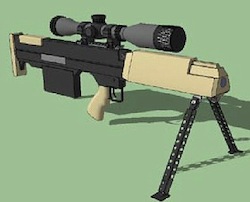
Concept of the rifle, from the Daily Mail
The developer is Photonic Security Systems, which also markets the rifle as a pirate deterrent. The Telegraph says that similar devices have been used in Afghanistan by NATO-led International Security Assistance Force troops.
PSS managing director Paul Kerr told the International Business Times "The very purpose of this technology is to be non-damaging … If someone is prepared to just stand there and stare down the barrel at this, which would be incredibly uncomfortable, then they are definitely a threat.” He said that he has often been exposed to the laser: "The quality and safety of the device is paramount and I know that first hand because I have been the guinea pig many times. I know what it is like and I know how effective it can be."
Author and activist Cory Doctorow points out that “the UK is a signatory on the Protocol on Blinding Laser Weapons … this weapon wouldn’t run afoul of international law if it (merely) reduced your vision to the point where you were impaired but not legally blind, permanently.” Doctorow also says “Twitter wags are already predicting a resurgence of mirrorshades [reflective sunglasses] among protesters.”
From the Telegraph, the Daily Mail, the International Business Times and BoingBoing. See related story on BAE Systems anti-pirate dazzler.
.
Halloween special: Are green beams in UK laser pens or UFOs?
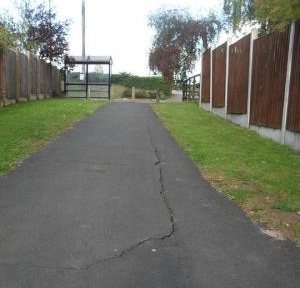
Could a UFO with green lights have caused this crack?
It follows a report to the Halstead Gazette and a UFO website that a resident saw green lights rotating above her in Nether Court on Friday and left a large crack in the ground.
The frightened woman's daughter, who would only be identified as Nel, called Essex Police after the 7pm incident to check if it was the force helicopter. A police spokesman said it was not the helicopter but could have been laser pens.
But Nel is adamant it was not laser pens, and has since carried out internet research suggesting similar beams have been seen in diverse places such as Cornwall, Mexico, Nova Scotia and China.
From the Halstead Gazette on October 28 2011. Also, see this post at UK UFO Sightings; scroll down for the comment from Nel.
.
.
UK: BALPA wants lasers classified as weapons and banned EU-wide
From The Independent and the Daily Mail
.
UK: Heathrow laser incidents almost triple
From BBC News
UK: 270% rise in Surrey-area laser pen incidents
A spokesperson pledged to “deal robustly with any incident involving laser light whether it is an assault on another member of the public or a device being pointed at a vehicle. Laser pen owners should also be aware that Surrey Police’s collision investigation unit can pursue a manslaughter charge if it is found that a fatal or life changing injury collision is due to the use of a laser light. All offences have a power of arrest and could result in a term of imprisonment.”
Police are especially concerned about aircraft illuminations in East Surrey, near Gatwick Airport.
From Elmbridge Today, BBC News, and Redhill and Reigate Life. A list of laser pen offences, compiled by the Surrey police, is here.
UK: Laser "dazzler" from BAE Systems for use against pirates and other threats
Roy Clarke, BAE Systems capability technology lead for laser photonic systems, said: “The effect is similar to when a fighter pilot attacks from the direction of the sun. The glare from the laser is intense enough to make it impossible to aim weapons like AK47s or RPGs, but doesn’t have a permanent effect.”
From the BAE Systems press release.
UK: Laser beam air attacks on rise
Some of the more interesting quotes:
- Pilot Kevin Medlock: "It's so brilliant, it takes away part of your vision for a few minutes at least. We fly an aircraft, 148 passengers, making an approach to landing at 170 miles per hour. The consequences of someone shining a laser in my eyes at that stage of flight isn't worth bearing the consequences." Medlock was hit by laser beams twice in one month.
- "What's worrying experts is the rate at which the problem is growing:" 29 U.K. attacks in 2007, 206 attacks in 2008, and 461 in 2009 (through September).
- (video of teen walking into court) "This man said he was trying to see how far his laser could reach. Dean Bottomley was sent to jail."
- Captain Bob Jones, U.K. Civil Aviation Authority: "We're trying to raise the awareness of the general public, rather than worry or frighten them."
From BBC News
UK: Police "fight back" by tracking laser hits

1: Police helicopter is targeted by laser pointer on the ground. 2: Helicopter crew use Laser Event Recorder to locate pointer via GPS, and record its wavelength. 3: GPS details enable helicopter’s thermal (infrared) camera to find suspect, and send police patrol on the ground to arrest the person.
In addition, the UK’s Civil Aviation Authority is planning new laws prohibiting shining a laser at an aircraft. Currently, prosecutors have to prove that the laser user “recklessly or negligently endangered an aircraft”.”
BBC quotes Bob Jones, head of flight operations at the CAA: “"To those individuals targeting aircraft with laser devices the message is clear -- don't. You will be caught and you will be prosecuted and you could spend up to five years in prison. These things are not toys, they pose a serious risk to all flight safety."
Many more details, including photos and a video of a helicopter finding a laser perpetrator, are at the BBC News website.
UK: 5 mW laser pointers seized
Click to read more...
UK: Growing concern over laser pointers
The pilot, who was over Stockport at the time, was temporarily blinded. Unable to read his instruments, he had to make dangerous emergency manoeuvres.
This case highlights a growing concern about the inappropriate use of more powerful green laser pens or pointers.
Britain's largest pilots union BALPA has recently warned of a major air disaster unless action is taken.
Click to read more...
UK: eBay, Amazon remove high-powered pointers
The move follows a BBC investigation which found some of these potentially dangerous products were being sold irresponsibly by individual traders.
Click to read more...
